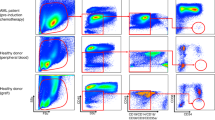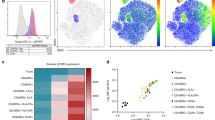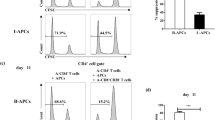Abstract
We show here that the anti-T lymphocyte immunoglobulin (ATG) can induce Treg cells following 24-h incubation in human peripheral blood mononuclear cells (PBMCs). The ATG-induced Treg cells express known cell surface markers (e.g., CD25, FoxP3) and suppress the proliferation of autologous responder PBMCs, stimulated with allogeneic PBMCs, when added into the mixed lymphocyte culture (MLC) at zero time point or 48 h later. We expanded the characteristics of the ATG-induced human Treg cells by showing that they express a novel biomarker designated “activated CD44”. ATG-induced Treg cells retain their suppressor function after freezing and thawing or irradiation. Suppression of MLC by ATG-induced Treg cells is consistently seen when the Treg cells and the responder cells were derived from the same donor, but not when they derived from different donors. Finally, patients undergoing stem cell transplantation and conditioned with ATG generate in vivo Treg cells that suppress MLC.









Similar content being viewed by others
References
Mothy M. Mechanism of action of antithymocyte globulin: T cell depletion and beyond. Leukemia. 2007;21:1387–94.
Vignali DA, Collison LW, Workman CJ. How regulatory T cells work. Nat Rev Immunol. 2008;8:523–32.
Lopez M, Clarkson MR, Albin M, Sayegh MH, Najafian N. A novel mechanism of action for anti-thymocyte globulin: induction of CD4+CD25+FoxP3+ regulatory T cells. J Am Soc Nephrol. 2006;17:2844–53.
Feng X, Kajigaya S, Solomou EE, Keyvanfar K, Xu X, Raghavachari N, et al. Rabbit ATG but not horse ATG promotes expansion of functional CD4+CD25highFOXP3+. Blood. 2008;111:3675–83.
Ruzek MC, Waire JS, Hopkins D, Lacorcia G, Sullivan J, Roberts BL, et al. Characterization of in vitro antimurine thymocyte globulin-induced regulatory T cells that inhibit graft-versus-host disease in vivo. Blood. 2008;111:1726–34.
Broady R, Yu J, Levings MK. ATG-induced expression of FOXP3 in human CD4(+) T cells in vitro is associated with T-cell activation and not the induction of FOXP3(+) T regulatory cells. Blood. 2009;114:5003–6.
Vogt Sionov R, Naor D. Hyaluronan-independent lodgement of CD44+ lymphoma cells in lymphoid organs. Int J Cancer. 1997;71:462–9.
Naor D, Vogt Sionov R, Ish-Shalom D. CD44: structure, function and its association with the malignant process. Adv Cancer Res. 1997;71:241–319.
Naor D, Nedvetzki S, Golan I, Faitelson Y. CD44 in cancer. Crit Rev Clin Lab Sci. 2002;39:527–79.
Nedvetzki S, Gonen E, Assayag N, Reich R, Williams RO, Thurmond L, et al. RHAMM, a receptor for hyaluronan-mediated motility compensates for CD44 in inflamed CD44-knockout mice: a different interpretation of redundancy. Proc Natl Acad Sci USA. 2004;101:18081–6.
Pure E, Cuff CA. A crucial role for CD44 in inflammation. Trends Mol Med. 2001;7:213–21.
Firan M, Dhillon S, Estess P, Siegelman MH. Suppressor activity and potency among regulatory T cells is discriminated by functionally active CD44. Blood. 2006;107:619–27.
Bollyky PL, Lord JD, Masewicz SA, Evanko SP, Buckner JH, Wight TN, et al. Cutting edge: high molecular weight hyaluronan promotes the suppressive effects of CD4+CD25+ regulatory T cells. J Immunol. 2007;179:744–7.
Liu T, Soong L, Liu G, König R, Chopra AK. CD44 expression positively correlates with Foxp3 expression and suppressive function of CD4+ Treg cells. Biol Direct. 2009;4:40.
Min B, Thornton A, Caucheteux SM, Younes SA, Oh K, Hu-Li J, et al. Gut flora antigens are not important in the maintenance of regulatory T cell heterogeneity and homeostasis. Eur J Immunol. 2007;37:1916–23.
Littman DR, Rudensky AY. Th17 and regulatory T cells in mediating and restraining inflammation. Cell. 2010;140:845–58.
Chung DT, Korn T, Richard J, Ruzek M, Kohm AP, Miller S, et al. Anti-thymocyte globulin (ATG) prevents autoimmune encephalomyelitis by expending myelin antigen-specific FoxPox3+ regulatory T cells. Int Immunol. 2007;19:1003–10.
Korn T, Bettelli E, Oukka M, Kuchroo VK. IL-17 and IL-17 cells. Annu Rev Immunol. 2009;27:485–517.
Kahaly GJ, Shimony O, Gellman YN, Lytton SD, Eshkar-Sebban L, Rosenblum N, et al. Regulatory T-cell in Graves’ orbitopathy: baseline findings and immunomodulation by anti-T lymphocyte globulin. J Clin Endocrinol Metab. 2011;96:422–9.
Acknowledgments
This research was supported by a non-restricted grant from Fresenius Biotech GmbH, Munich, Germany.
Conflict of interest
The authors declare no conflict of interest.
Author information
Authors and Affiliations
Corresponding author
Additional information
Orly Shimony and Arnon Nagler equally contributed for the project described in this manuscript.
Rights and permissions
About this article
Cite this article
Shimony, O., Nagler, A., Gellman, Y.N. et al. Anti-T Lymphocyte Globulin (ATG) Induces Generation of Regulatory T Cells, at Least Part of Them Express Activated CD44. J Clin Immunol 32, 173–188 (2012). https://doi.org/10.1007/s10875-011-9599-2
Received:
Accepted:
Published:
Issue Date:
DOI: https://doi.org/10.1007/s10875-011-9599-2




